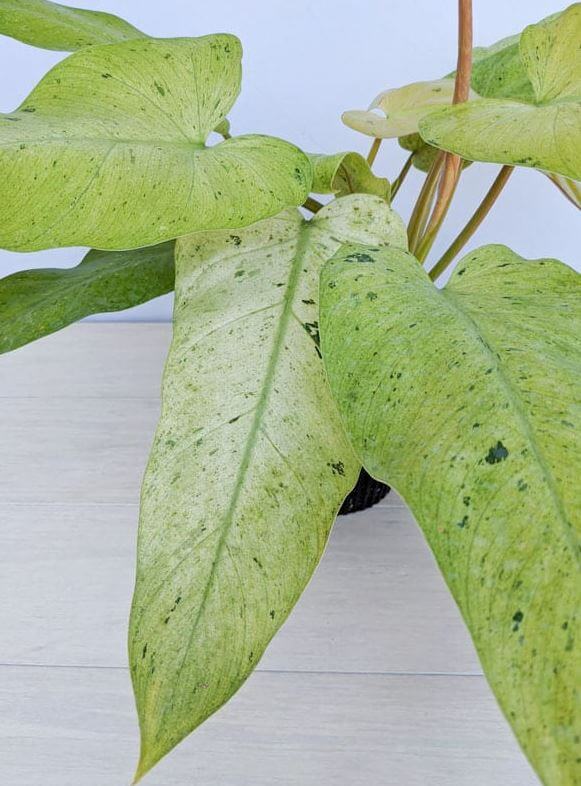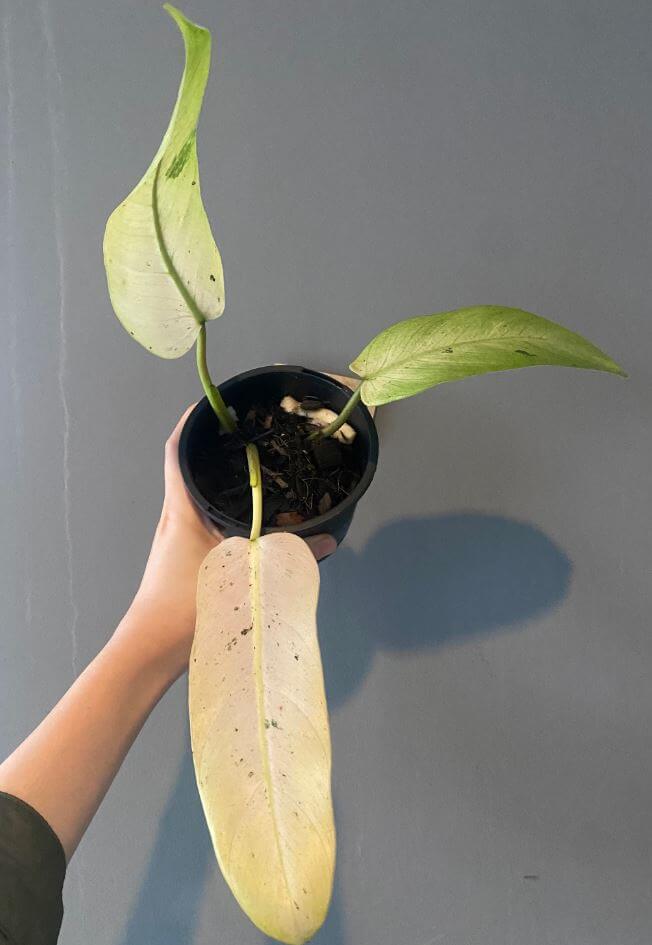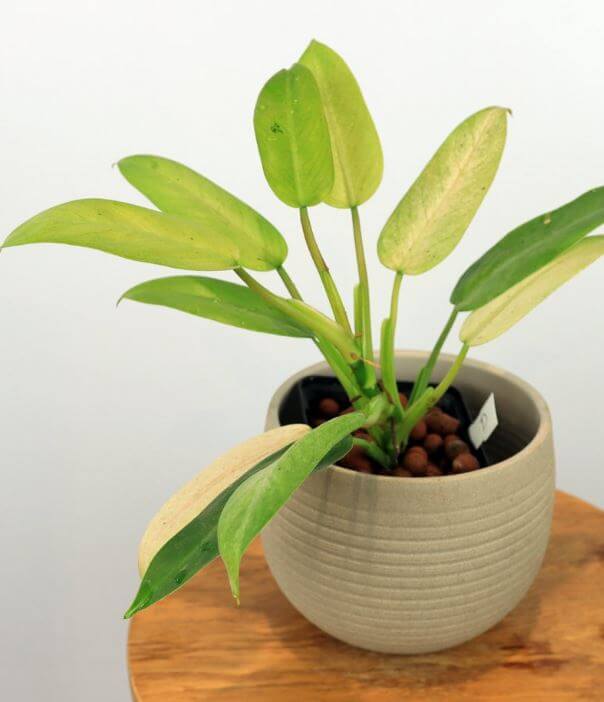Last Updated on February 23, 2023 by a Friendly Gardener
If you love rare houseplants, the Philodendron Whipple Way merits consideration, but it isn’t that easy to find. Although you may not see one in a nursery or garden center, it’s even a challenge to find one online. Considering their beauty, this may change in the future but for the moment, this is one rare plant to have in your indoor garden and they can be very expensive if you do find one.
A Philodendron Whipple Way boasts vibrant lemon-green hued to white foliage and resembles a vining plant more than other varieties of philodendron. The characteristic variegation is due to a mutation, so this is not a variety grown from seed, but from cuttings. Long sword-like leaves emerge from a large central stem featuring numerous shades and combinations of green and white and a few may even sport some pink.
This philodendron variety was created from a sport Philodendron Domesticum in California and was named for the street where the growers resided, hence ”Whipple Way”. This plant is rare because it was shared within a small group of growers in the U.S. although it can be found through niche cultivators online. The smallish supply group accounts for the expense involved in acquiring this philodendron variety.
Philodendron Whipple Way Plant Care

This philodendron is relatively easy to care for especially if you have some experience with philodendrons. With proper care, the Whipple Way can reach 2 to 3 feet in height and foliage as much as a foot in length. New growth will emerge from a characteristic pink covering or cataphyll.
Soil

The ideal growing medium will be quality, well-draining soil with moisture retention. If you are using an indoor potting mix, make sure to add in some perlite or pumice to ensure draining. Horticultural charcoal can also be beneficial.
Light
The Whipple Way philodendron loves the sun, so bright light is a plus especially to aid in maintaining variegation. It will adapt somewhat to lower light levels, but this will affect the variegation and may result in darker leaves. The more sun your plant receives, the paler foliage will be. Do take care to not exaggerate so that leaves become scorched. Windows facing the north are east are ideal.
Water

As with all houseplants, the best way to know if your plant needs watering is to feel the topsoil. Poke the soil bed with a finger at least two inches deep. If the soil feels dry, go ahead and water. If you feel dampness, wait for a day or two. Whipple Way philodendrons do have a bit of drought resistance, so don’t fret if the soil bed has dried out. Make it a point to the water near the soil surface deeply until excess water runs from the container’s drainage holes.
Humidity
Indoor humidity in the 60% range is best for this plant as it will contribute to a faster growth habit.
Temperature
The Whipple Way philodendron does not enjoy the cold particularly if prolonged. Avoid placing this plant near heating or air conditioning units or vents and in drafty locations. This cultivar likes an environmental temperature measuring in the 55° to 80° F. range. It can be cultivated outside if you reside in USDA hardiness zones 9b to 11 and the local temps remain in the recommended range. Another consideration for outdoor cultivation is the sun’s intensity. Beware of drying or crispy leaves that indicate the need for a bit of shade.
Feeding
The philodendron Whipple Way is considered a light feeder. Slow-release fertilizers are a good choice if you want to prevent any root burn from salt buildup. This also aids in preventing overfertilization.
Pruning
Remove dried-out or dead leaves as needed. If stems have dried or appear diseased, trim these off as well.
Repotting a Whipple Way Philodendron

Plan on repotting your philodendron every third year unless you notice roots peeking from drainage holes or your plant requests more water. These signs indicate it’s time to repot. When repotting, do so in the spring during the start of the growing season. Choose a container no more than two inches larger than the original pot.
Pests and Problems
Examine your plant regularly for pest infestations. Look for these types of evidence:
- Fungus gnats. These flying pests resemble fruit flies and are characteristic of plants that are overwatered.
- Spider mites. Practically invisible to the eye, look for webbing on leaf undersides or stippling on leaf tops.
- These appear as waxy bumps on leaves and stems.
- Pear-shaped insects in a variety of colors.
- These sapsuckers look like cottony deposits that tend to cluster.
To treat an infested plant, you will be able to remove some manually like scale of mealybugs, or with jets of water. However, your plant should be treated with insecticidal soap spray or a diluted Neem oil spray to eliminate pests permanently.
Root rot is a common disease found in overwatered houseplants. When soil remains soggy, there is a good chance this fungal infection will strike. Foliage may appear mushy or soft and will droop. The affected root system will also turn mushy, and decay will set in. If you suspect root rot, remove your philodendron from its potting soil and examine the roots. If some roots are still firm and healthy, trim away infected roots, rinse the remaining healthy roots, and replant them in fresh soil. Wait at least a week before watering again.
Whipple Way Philodendron Propagation

To propagate your Whipple Way successfully, use stem cuttings. The plant should be healthy and stable. Do not use a new plant that is still adjusting to the environment. Trim a section of stem below a leaf node and remove foliage from the bottom half of the cutting. Place this stem section in a container of loose well-draining soil and position it in bright, indirect sunlight. Do not feed and water when the soil is dry.
Whipple Way Philodendron Toxicity
Unfortunately, philodendrons are toxic to people and pets, so keep this lovely plant out of reach.

